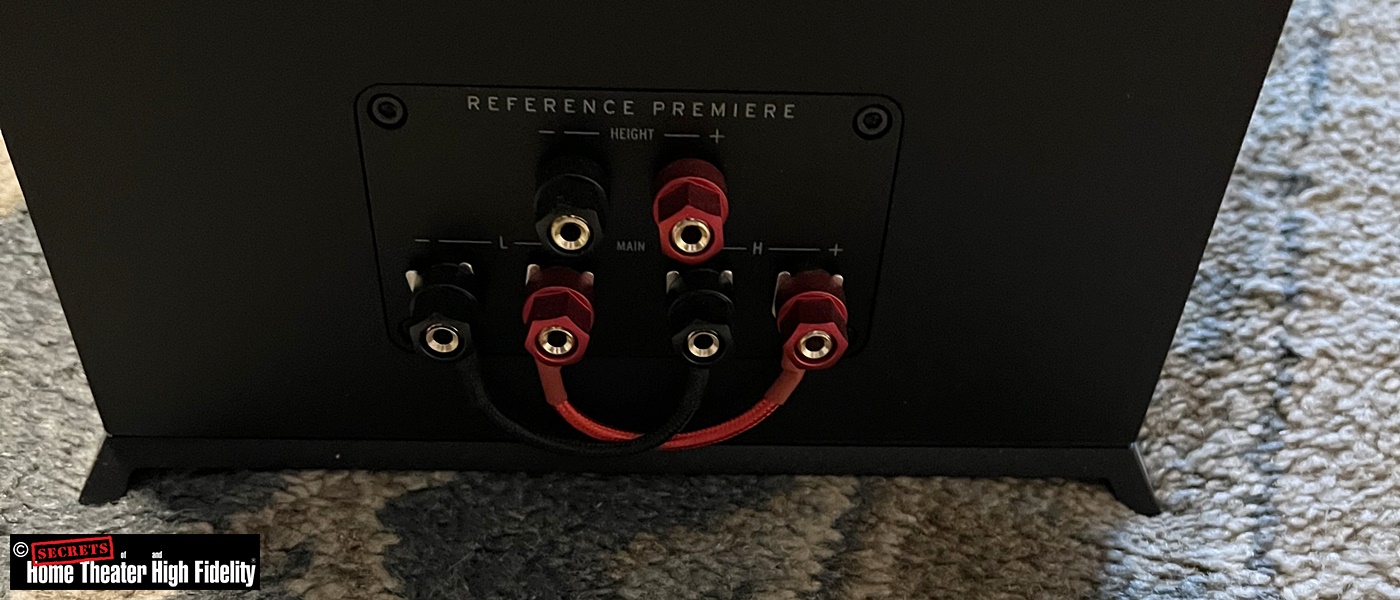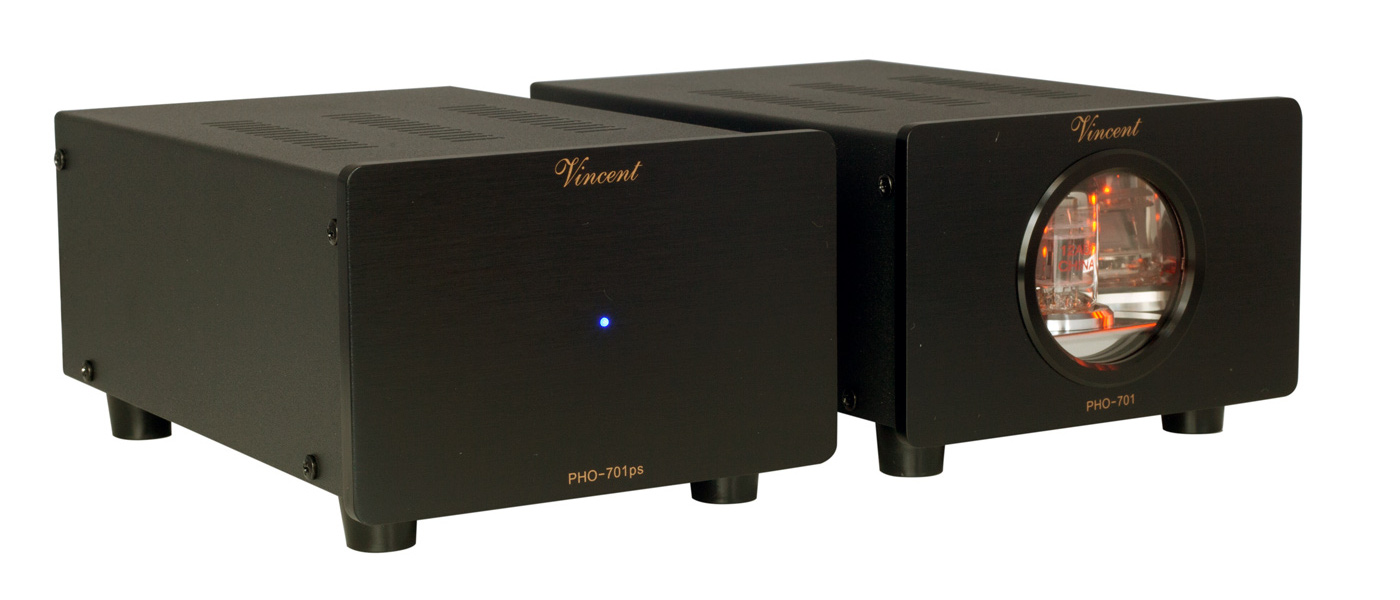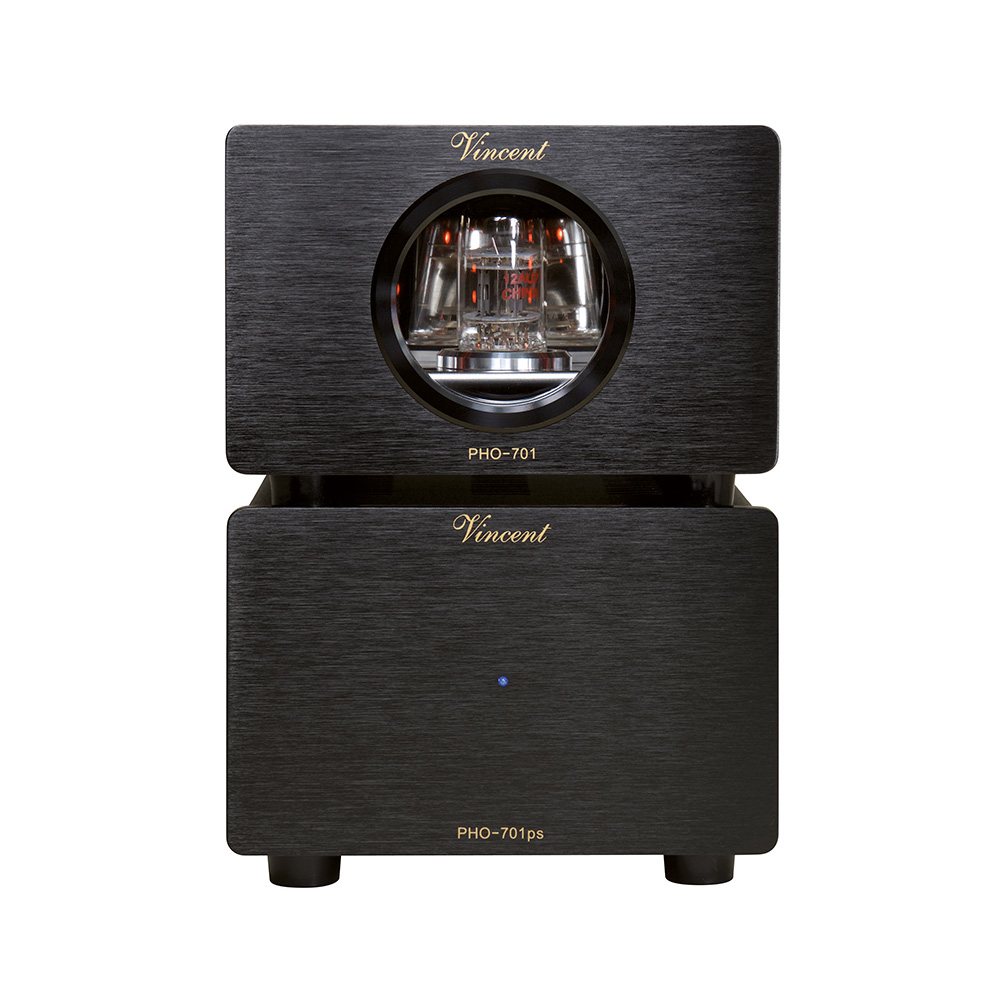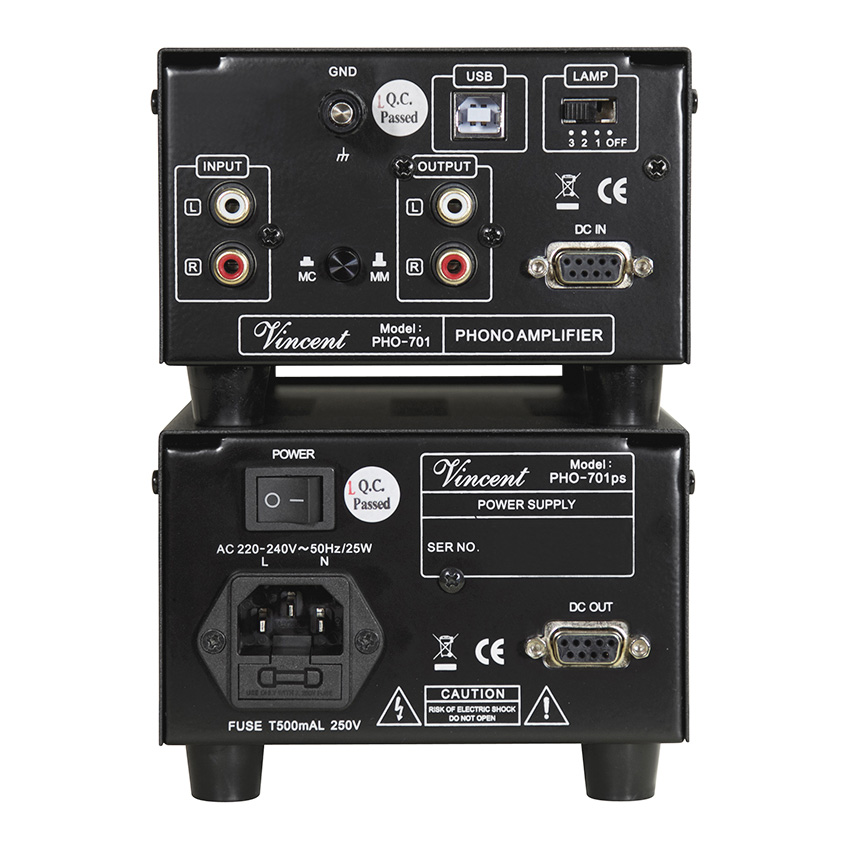I was not expecting the Vincent PHO-701 to sound as good as it does. I also did not expect that the easy and comprehensive cartridge loading tunability would be so useful. But it does sound great, and the easy-to-access cartridge loading tuning has significantly improved the sound of my analog rig.
Vincent PHO-701 Phono Preamp Highlights
- Exceptional sound quality for the money.
- Unexpected “high-end” features like a power supply in a separate chassis and very good build quality.
- Comprehensive cartridge loading tuning, with adjustments accessible without opening the case and adjustable while the unit is operating.
- Tube output stage sounds great, but without too much “tube sound” coloration.
- USB digital output for digital transcription.
The phono preamp is one of the more sensitive parts of a HiFi system. It has to take a very, very weak signal measured in single-digit millivolts, and amplify it by a factor of a million or so (in power) before it can be used by your normal preamp. And your preamp is already a low-level signal device that’s difficult enough! Therefore, phono preamps should be expensive. So, I’m always a little dubious of “budget” phono preamps. It’s really easy to get it wrong. When I was asked to review the Vincent PHO-701, I was also a bit suspicious. But Vincent does use the same model as our perennial favorite Emotiva to maximize value. Vincent components are all engineered in Germany but are made in Asia under contract. Still, the Vincent seemed to pack an awful lot into its spec sheet for the asking price of only $799. MC/MM capability with solid claimed specs, highly adjustable cartridge loading, a two-chassis design with a separate power supply, a tube output stage, and even a 24-bit, 192 kHz analog to digital converter for digitizing albums. Would all those specs for that little money actually sound good? Would it be better than the well-regarded built-in phono preamp in my Rogue RP-1 preamp? I’m pleasantly surprised to say yes.
Frequency Response:
10 Hz – 20 kHz
Harmonic Distortion:
< 0.05 % (20 Hz - 20 kHz)
Input Sensitivity:
MM: 58 mV, MC: 6.8 mV
Signal-Noise Ratio:
MM: > 81 dB, MC: > 69 dB
Input Impedance:
MM: 47 kOhm, MC: 99 – 1000 Ohm (adjustable)
Input Capacity:
MM: 15 pF – 350 pF (adjustable), MC: 15 pF
Output Impedance:
250 Ohm
Amplification Factor:
MM: 40 dB, MC: 60 dB
Max. Power Consumption:
15 Watt
Inputs:
1 x Stereo RCA
Outputs:
1 x Stereo RCA, USB (24 Bit / 192 kHz)
Tubes:
1 x 12AU7
Color:
Black or Silver
Weight:
4.8 lbs.
Dimensions (W x H x D):
5.1 x 3.7 x 8.9 in for each box
MSRP:
$799
Website:
Company:
SECRETS Tags:
Preamp, preamp reviews, amplifier reviews, preamp reviews 2023, Vincent preamp, Vincent preamp reviews
The PHO-701 is the top-of-the-line phono preamp from Vincent. Like the PHO-500, it is a dual chassis design, with the power supply in one enclosure, and the preamp in another identically sized box. The power supply has an IEC connector for power, a power switch on the rear panel, and a D connector to provide power through a provided cable to the preamp. The preamp box itself houses a solid-state preamp board, followed by a separate board containing a unity gain vacuum tube follower. The tube is a single 12AU7 in a dual triode configuration to act as a follower for both stereo channels. There’s a nice window on the front panel revealing the tube. There’s also an adjustable internal lamp to backlight the tube if you prefer. This lamp has three brightness settings plus off. I turned the lamp off myself. In the dark, you can still see the tube glow a bit on its own. The build quality of the preamp was very good for the price, with a nicely machined aluminum front panel. My review unit was provided in black, so the front panel was black anodized with a black-painted main enclosure. That main enclosure is steel sheet metal a ’la mass market electronics, but with a panel thickness that’s at least 50% thicker than typical, giving the preamp a very solid feel. The preamp is also available with a silver anodized front panel and black-painted main enclosure. Rear panel connectors and switches are by no means high-end, but get the job done. Nothing felt cheap to me. The rear panel of the preamp has the D connector power input, the lamp switch, plus a MM/MC button for switching gain modes. RCA inputs and outputs are provided along with a thumbscrew terminal for the phono ground wire. This was particularly nice rather than having to fumble with a screwdriver. There’s also the USB output for the provided 24-bit 192 kHz analog to digital converter. This converter operates all the time and is constantly outputting a USB audio signal if you want to digitize any records. No software is provided, so you’d need to record and edit the recordings on your own. Vincent does not specify what ADC chip is used. I see this as a nice extra feature, but this device is not a purpose-built tool to digitize your record collection.
Secrets Sponsor
The underside of the preamp box does turn out to have an exceptionally useful feature, although it might not appear so at first glance. The DIP switch banks to set cartridge loading (one for each stereo channel) are exposed on the bottom of the preamp box. The PHO-701 offers an exceptional range of cartridge loading settings. There are 15 settings for the real part of the input impedance from 99 ohms to 1000 ohms with a fixed capacitance of 15 pF for the MC input and 4 capacitance settings between 15pF and 350 pF with a fixed real impedance of 47 kOhms for the MM input. Not only is this a very wide range of adjustment for both types of cartridges, but having the switches exposed on the outside of the box turned out to be an enormous benefit to getting the most out of my analog setup. With my very nice Rogue RP-1 preamp, you need to remove the top lid to access the switches. And to get to the switches inside you definitely need to take it out of the rack. And it’s risky to then run it with the cover off. One poke in the wrong place and ZAP!, off to the emergency room (or morgue) for you. With the Vincent, you just need to turn the preamp box upside down or on its side. The DIP switches are then easy to access in operation, allowing you to carefully listen to changes in sound as you change loading. This makes it super easy to optimize the loading. I guarantee that if I had to stop listening, pull the preamp out of the rack, make an adjustment, and put it all back, I’d forget what the system sounded like by the chance I was able to listen with the new setting. With the Vincent, you can A/B compare loading settings in literally seconds without stopping playback. It takes longer to get up out of your listening chair and sit back down again than it does to change the loading setting. This one feature turned out to be by far the most valuable for me. And if you don’t want tubes, the Vincent PHO-500 offers the same feature. In fact, the PHO-500 is basically the same preamp but without the vacuum tube follower circuit and costs $100 less. While I didn’t listen to it, I’m sure it’s similar. So, whatever you prefer, tubes or not. Of course, features don’t mean a thing if the component doesn’t sound good, so onto listening!
Secrets Sponsor
I turned on the PHO-701 and left it on all the time while I was listening. Before any critical listening, I let the unit burn in by leaving it turned on all the time for a week. As with any tube component, warm-up is important to have the circuit be at its nominal operating conditions. I initially set the cartridge loading at 1 kOhm, since that’s where I had my Rogue RP-1 set. Audio Technica recommends a loading of at least 100 ohms for my AT-ART9XI moving coil cartridge. The 0.5mV output of this cartridge turned out to be pretty well matched to the 60 dB of gain the PHO-701 delivered. If you have a super low output cartridge, you’ll probably want something with more gain or will have to use a step-up transformer. Upon listening, I immediately noticed improved detail retrieval from the Vincent preamp.

Mark Lanegan “Whisky for the Holy Ghost”
I have a specific album I use to test this in my system. It helps that it’s also one of my favorites: Mark Lanegan’s Whiskey for the Holy Ghost. I have this album on brand new heavy vinyl and also in high-resolution digital format. To my ears, the analog sounds better. More real and present. But digital does extract more detail. On “The River Rise” and “Borracho” Lanegan’s naked voice and simply recorded guitar is a challenge to reproduce. That lifelike presence is always better with the vinyl, but all the subtle details of the voicing and the guitar strings are superior on the digital recording. The improved detail extracted by the PHO-701 brought the analog recording closer to the digital in terms of detail extraction while simultaneously preserving the lifelike presence of the analog recording. That first track is only voice and guitar. Nothing else. “Borracho” adds drums. Compared to the analog, the digital had the edge in terms of bass weight and impact from the drums. But then I decided to play around with the cartridge loading. If the impedance is too high, the bass can sound thin and light. Too low, and the opposite can happen. Too warm and wooly.
Tonal balance can change too. Lower impedance tends to roll off the highs. I switched to 99 ohms, the lowest setting and the minimum recommended by Audio Technica for my cartridge. I thought this over-emphasized the bass, rolled off the highs too much, and sounded less well-controlled. So, I started to play around. I eventually settled on loadings of around 300 ohms. This put the tonal balance where I thought it sounded most natural and had the best bass weight and control. There’s a big step in the adjustment range that goes from 293 ohms to 130 ohms. 130 was definitely too low. 293 was great, as were 319 and 364. The weird resistor values are because the PHO-701 has a permanently engaged 1000-ohm resistor and four more resistors in parallel that can be selectively engaged with the DIP switches. The values you can get for the total impedance are those resistors added in parallel, leading to the weird numbers.
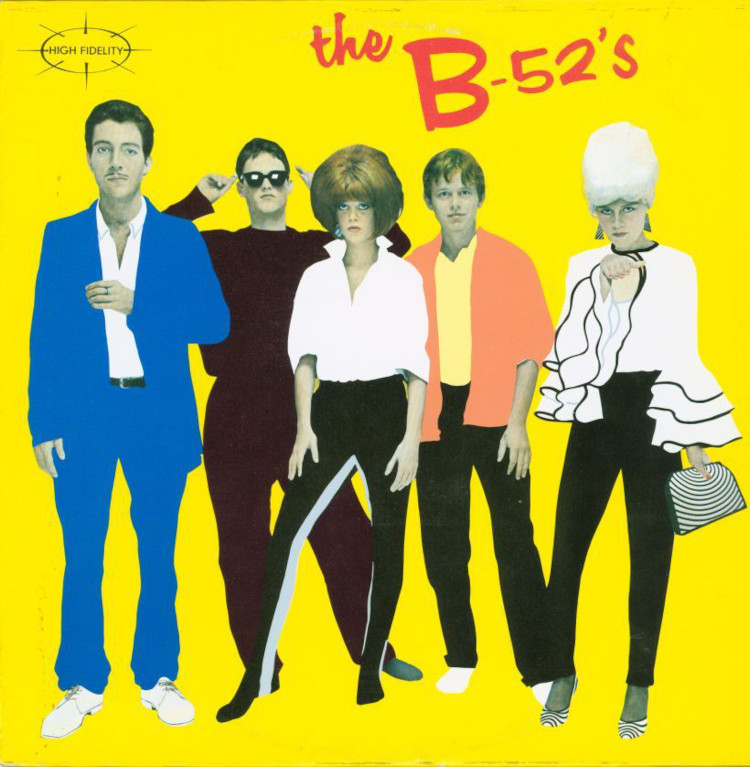
The B-52s “Cosmic Thing”
With the loading optimized, the bass extension and impact of my analog system rivaled the high res digital from my Chord Mojo. I think the digital still had the edge in sharpness and cleanness of bass transients, but it was close. This added a lot of life and drive to my collection of B-52s albums (all of them on every track).

Calexico “Feast of Wire”
One of my favorite songs on Calexico’s Feast of Wire, “El Guero Canelo”, had me listening to it over and over because it sounded so great. That song is also an excellent test of detail retrieval, with the vocals being done through a highly distorted squawk box. In a system with really good detail retrieval, you can hear and understand all the lyrics. But in a system where the detail retrieval is compromised, good luck. The PHO-701 had my analog system doing the best job it ever had with this track. Still not quite as clear as the digital but a lot closer and definitely more “alive” while it was doing it.
And none of this would have been as easy or as fast if I couldn’t adjust the loading while listening. All I had to do was get up, flip a couple of DIP switches, and sit back down, never stopping playback. I was able to hone in on just the right setting in one listening session. I can even play with the “good” sounding settings album to album if I want. It’s that easy. One thing I never noticed while I was listening to the PHO-701 was any sort of “tube” sound. It definitely has the tube, but it didn’t sound “tubey”. I didn’t have the solid-state PHO-500 to compare, but if you’re worried about the 701 sounding too warm, I wouldn’t. It just sounded good. Honestly, for the price, I really can’t complain. Are there better phono preamps? Yes, of course. But they cost a lot. The PHO-701 is definitely better than the phono preamp in my very good Rogue RP-1, and that particular unit has a pretty good reputation for a built-in phono preamp.
The PHO-701 is an excellent value phono preamp. For $799 you get a lot of very useful stuff, and excellent sound across the board. It’s hard to fault it. Some may complain about the Asian manufacturing, which I can understand. But you can’t have something for nothing. Doing as well as the PHO-701 in a US or European-manufactured preamp will cost you significantly more. With all the features the Vincent offers, probably two times more to get the same performance. I’m very happy with it.
- Superb bang for the buck in terms of sound quality.
- Lots of high-end features, like a separate power supply and tube output stage.
- Exceptional cartridge adjustment flexibility, with super easy and convenient adjustment while operating.
- Very good build quality for the price.
- I can’t really think of anything more they could do.
The Vincent PHO-701 is a fantastic phono preamp for the price. It offers great sound, besting the built-in phono preamp of my very good Rogue RP-1. It has a boatload of features, very good build quality, and the super useful ability to easily adjust cartridge loading in operation. I really can’t fault it. I can’t think of another phono preamp at anywhere near the PHO-701’s price that can offer as much, except maybe Vincent’s own PHO-500. I was very pleasantly surprised and impressed.


